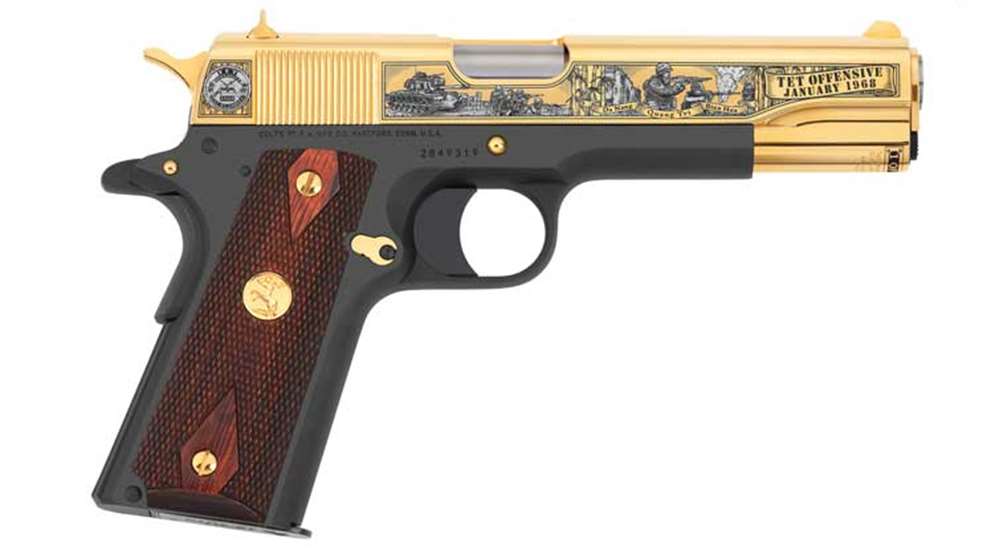
In honor of the upcoming 50th anniversary of the Tet Offensive and all Americans who served in Vietnam during the Vietnam War, America Remembers has announced an exclusive Tet 50th Anniversary Tribute Pistol, a working Colt Government Model pistol in caliber .45 ACP—a classic military firearm, and a trusted sidearm during the Vietnam War. Only 1,000 Tributes will be issued in this edition. 
The artwork on the Tribute features battles scenes from urban settings, like Saigon and Hue. There is also an image of the flag raising over the Thuong Tu Gate at the Citadel in Hue. When Hue was overrun by the Communist forces, they quickly replaced the South Vietnamese flag, which flew at the Citadel with a huge Viet Cong banner. This banner could be seen throughout the city and was a daily reminder of the overthrow and occupation of this treasured Vietnamese city by the Viet Cong and the NVA. This scene shows a South Vietnam banner once again flying over the citadel after allied forces reclaimed the city on February 24, 1968.
On both sides of the slide is a crisscrossed M16 and M14, the rifles used during the Tet Offensive, with the date 1968 between them. "Tet Offensive" is scrolled at the top and "Lest We Forget" at the bottom, flanked by the familiar bamboo that was everywhere in Vietnam. Both sides of the slide also feature a banner that reads "Tet Offensive January 1968," commemorating this pivotal period in the war.
The artwork on the right side includes an M48 "Patton Tank." which helped provide cover and firepower in the urban setting, as our troops reclaimed the cities Da Nang, Quang Tri and Bien Hoa street by street. Saigon was the capital of South Vietnam and the surprise attacks on Saigon during the first night included an attempt to overrun the U.S. Embassy and to capture the National Radio Station.
Some history about the Tet Offensive from the America Remembers website:
It’s estimated that more than 2,500,000 Americans served in Vietnam. More than 58,000 lost their lives and another 350,000 were wounded. When the Tet attack started, America had more than 400,000 soldiers and Marine servicemen in Vietnam.
It was January, 1968. Over Christmas, Bob Hope, Raquel Welch and other entertainers were in Vietnam performing for the Christmas holiday—and a group of lucky troops were able to see the show live. Back at home, Americans were able to see highlights of the shows on television in January, ever mindful of all those who were serving in Vietnam.
With the start of the New Year, American troops were preparing for another year in Vietnam. Many longed to return home, and they counted down the days before their expected date to return home. The days were long and tedious and filled with uncertainty and danger.
In this faraway country, a major Vietnamese holiday was also approaching: Tet, the Vietnamese New Year. The Tet holiday was the most celebrated time in Vietnam, and a time when the fighting in Vietnam usually ceased for a short period. Many South Vietnamese soldiers were granted leave and joined family and friends for this special celebration.
Meanwhile, the North Vietnamese and Viet Cong had been planning for months a surprise attack on South Vietnam. The Communist forces would unleash a wave of attacks on South Vietnam while the South Vietnamese were celebrating their lunar New Year. With little warning, shortly after midnight, the sounds of combat exploded in Saigon and other locations in Vietnam.
The assault had started. The Tet Offensive was well-organized and conducted countrywide, eventually including more than 100 towns and cities. The Tet Offensive was by far the largest military operation conducted up to that point in the war, and it proved to be a pivotal turning point in the war.
A Marine Corps Combat Base was located at Khe Sanh, which was located 14 miles south of the DMZ, and about 6 miles from the Laotian border and the Ho Chi Minh Trail. For months, the NVA had built up significant forces around Khe Sanh, far outnumbering Americans and South Vietnamese forces. During the Tet Offensive, the NVA subjected the base to day and night artillery bombardment and mortar and rocket fire, and cut off the overland supply route to the base. The base would remain under siege for more than two months. America responded with heavy air strikes against the NVA forces.
The imperial City of Hue was a cultural center in South Vietnam, and formerly the capital of a united Vietnam. It’s reported that in a 1966 strategy meeting with President Lyndon Johnson, General Westmoreland had expressed the importance of Hue to the South Vietnamese. He realized that if the NVA ever captured Hue, it would have profound psychological impact on the South Vietnamese. The leaders of North Vietnam also recognized this important point, and so Hue was a key target in their planning for the Tet Offensive.
The fighting in Hue was intense, and lasted for four weeks. The Marines and South Vietnamese forces had to fight building to building, street by street, to reclaim the city. Much of the city was destroyed and losses on both sides were high. Hue was the longest sustained infantry battle the war had seen up to that point.
Quang Tri City was a target of the North Vietnamese during the Tet Offensive. It was in the north of Vietnam and an important government headquarters. It was an important target in 1968, but the attack was quickly defeated by the South Vietnamese and American forces. It was a major defeat for the NVA, and an important victory for the allied forces.
Bien Hoa and Da Nang were home to major military air bases for the United States Army, Air Force, and Marines. They were both attacked at the start of the Tet Offensive, but attacks were turned back by the allied forces.
For more information or to place an order for this pistol, please visit AmericaRemembers.com.






































